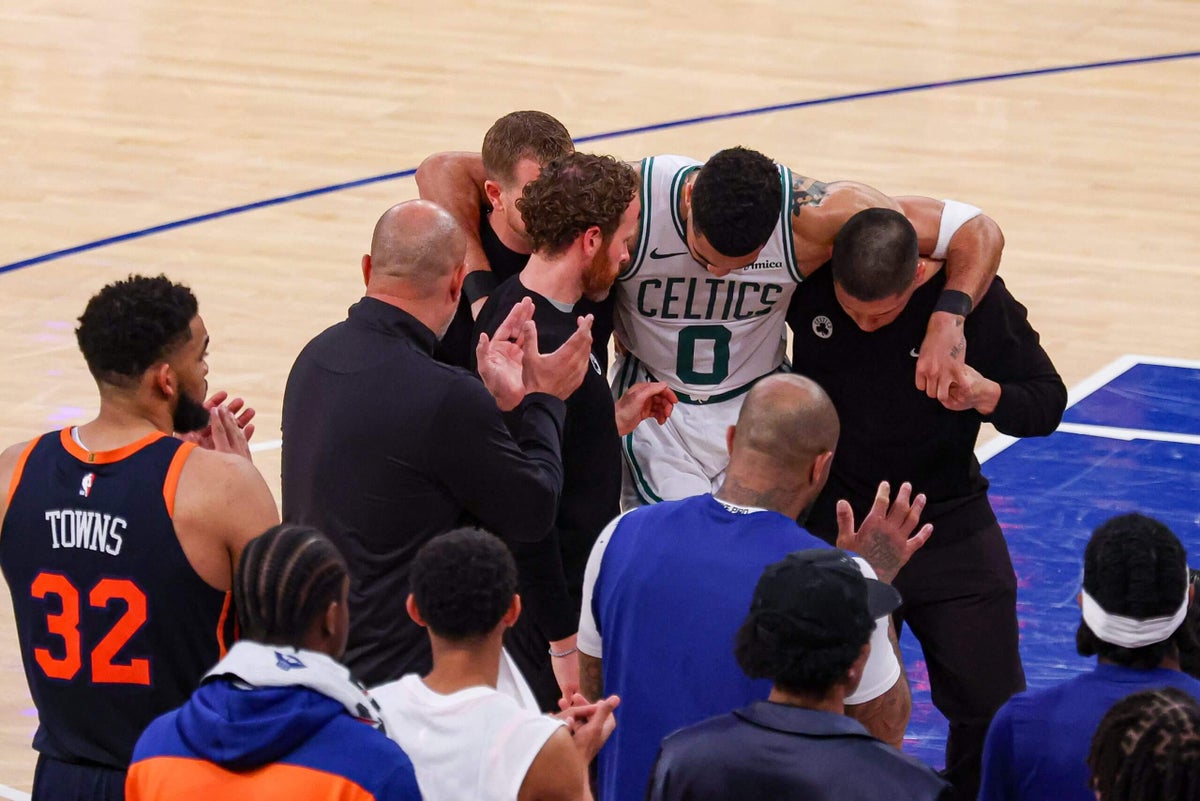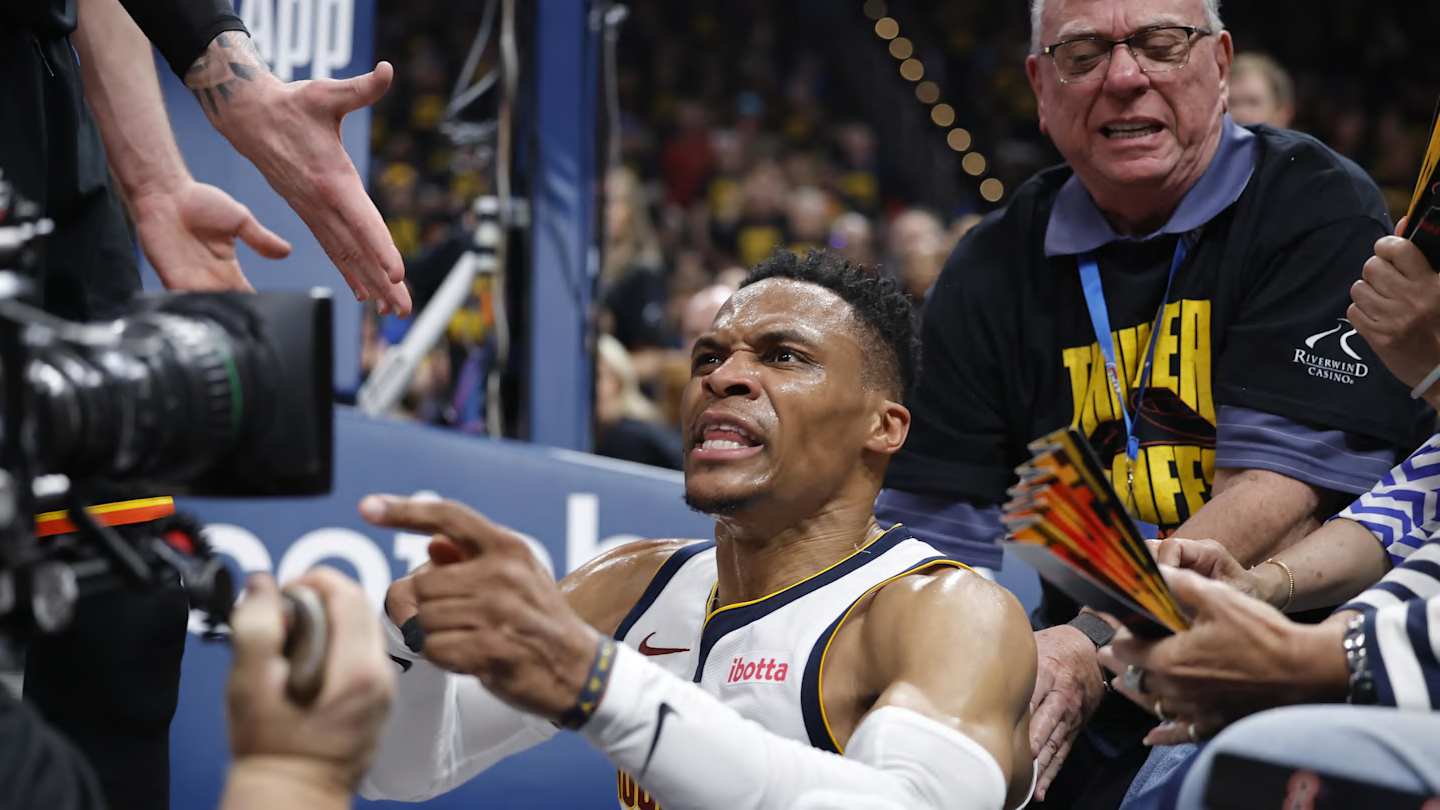
The history of the NBA is built on the rubble of crumbled contenders.
Injury haunts every plank of the basketball court. The fact that LeBron James hasn’t suffered a major tear in his multi-decade career is not just a feat, it’s borderline paradoxical. The injury, the surgery, the rehab: It’s almost a rite of passage in the NBA, one that Jayson Tatum finally has to conquer.
Advertisement
Tatum was one of the league’s ironmen, but the reality of sports is harder than metal. He spent his career transforming from a finesse shooter to a bulldozing driver, then suffered a career-altering injury in the most pedestrian way, late into one of the best games of his career.
All Tatum did was push off his back foot with 3:08 remaining in Boston’s 121-113 Game 4 loss to the New York Knicks, and his career, team and league were transformed. The Celtics announced Tatum had surgery to repair his right ruptured Achilles tendon Tuesday, with no timetable to return. The injury often takes 10-12 months to recover, but each case is different. It’s particularly distinct when it’s a 27-year-old with potentially another decade of star play ahead of him.
Tatum’s injury sends a seismic wave through the Celtics organization, but the aftershocks will be felt throughout the NBA. It’s rare that this caliber of player suffers this devastating an injury at this catastrophic a time of year in this seminal a moment for a marquee franchise.
This is a cruel reminder that winning is a privilege in this league, especially under the newest CBA, which has harsher penalties for high payrolls. Most years, the best healthy team wins. It is the truest through-line between champions.
This moment could diffuse the league’s center of gravity depending on what the Celtics do next. The NBA has orbited around Boston for most of the past two seasons. There are other teams with young players entering their primes who could be up next, but barring a Tatum-less Celtics turnaround in this series, this will be the seventh season in a row without a repeat champion. There’s not much reason to believe that will change anytime soon.
Now, the Celtics now enter this offseason a complete unknown.
The only thing guaranteed is the Celtics will not be the same team next season with Tatum on the shelf for most, if not all, of it. In the afterglow of a title, president of basketball operations Brad Stevens said on draft night nearly a year ago that his goal was to make the Celtics sustainable for years and years, even if some of those are down ones and even if they occasionally miss the playoffs.
Advertisement
“But it’s just not big dips,” Stevens said. “That’s what we would like. It’s hard to do because the other teams are good, too.”
Will this be the guiding principle for the rest of the league? The Celtics are proving that the dips are designed to come more frequently than ever under this new cap environment. They are already slated to be $37 million over next year’s projected luxury tax line and run the risk of paying escalating fees down the road if they continue to operate above the second apron in future years. The second apron also presents significant transaction and long-term draft pick consequences that hold greater weight now that the team is losing its best player. The new rule that freezes their draft picks seven years out seems more daunting now that Tatum’s mortality is finally showing, even as stars are pushing their primes deeper into their 30s.
But how deep do they want to dip? What is the consequence if a team as good as the Celtics goes into a full firesale at this point in their franchise curve? If their players are healthy next season, they could make a big difference for another playoff team.
The Celtics have represented a monolithic duality, a team that can win through a barrage of 3-pointers or the heroics of its two core stars. Even if they did lose to the Knicks with a healthy Tatum, the narrative would have been that the Celtics were just too beat up by the time the postseason came around. Maybe a longer offseason and the lessons from this year’s stunted playoff run would have them more prepared for next April. But that could all end up moot after Tatum’s injury.
There is a road back for Tatum to be a top-five player in the league again, but it will be a long one. He takes care of his body at as high a level as it gets in the NBA, so he’s a good candidate for a return to form.
Advertisement
He has a precedent to follow. Kevin Durant tore his Achilles in Game 5 of the 2019 NBA Finals and missed the following season while the Golden State Warriors tanked. Durant’s injury (and eventual departure in free agency) was coupled with Klay Thompson tearing his ACL in the very next game. It was one of the steepest drops from dynasty to devastation in memory.
But the Warriors were able to rebuild by taking their lumps for a year, reviving their roster and then beating Tatum and the Celtics in the 2022 finals a few years later. Boston could take a similar path. The key difference for the Warriors: They could retool around a healthy Steph Curry.
The Celtics were the franchise-building dream, with two young stars who could carry a contender for as long as they could envision. Now that dream is fractured, though not shattered. What does this tell us about the shelf life of star pairings in a draconian cap system? Now that the Celtics have dwindling hope of contending next season, we may find out.
The luxury tax was already looming, particularly with the transition to new ownership. The calculus used to be quantifying the value of a championship window before attrition slams it shut. Now, the question is whether the Celtics can keep their window open under this new CBA. The league is trying to figure out how heavy the weight of the second apron is, since it was born to kill dynasties.
“It’ll be interesting to see how it affects the league,” Stevens said on draft night last June. “That will be interesting to follow and look back and study over the next couple of years.”
Now, his team will be the key data point everyone is studying.
The Celtics front office loaded up the cap sheet long term, signing every member of the core rotation to long-term extensions outside of Al Horford. Teams are more willing to take on long-term salaries these days, because acquiring rotation players by trade is more feasible than free agency. Boston went down this road with plenty of exits along the way.
Advertisement
They can navigate their way through this retool, whether it’s salary-dumping Jrue Holiday after an injury-hobbled season or possibly moving co-star Jaylen Brown for a younger piece. (Someone like, say, Cooper Flagg?) One window closes so another can open.
No matter what happens, though, the cross-breezes just move faster these days. What even is a championship window at this point?
(Photo: Vincent Carchietta / Imagn Images)


